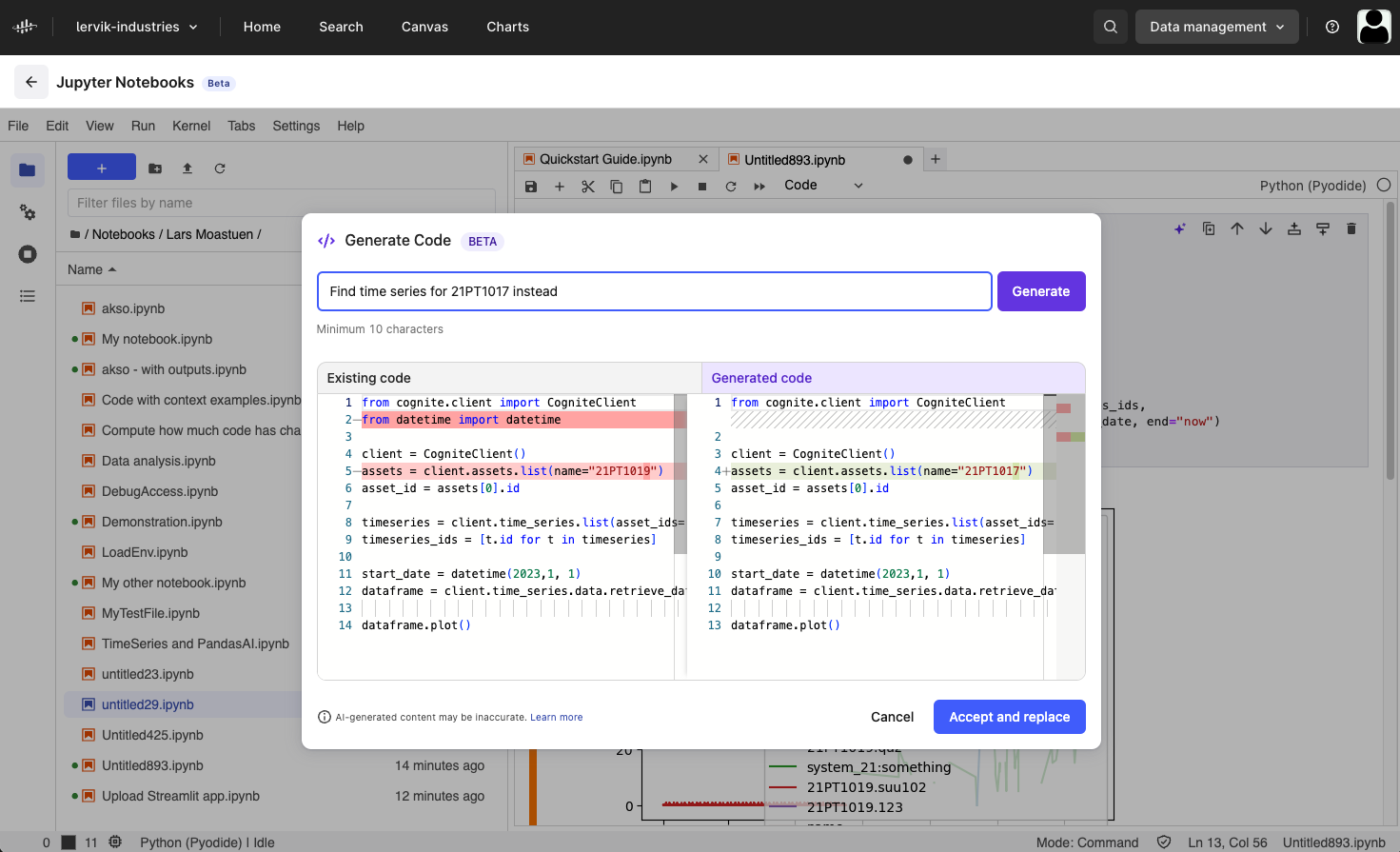- Permanently — all files are stored in Cognite Data Fusion and you can share them with other users. You can’t change the default files and folders.
- Temporarily — all files are stored temporarily in your browser. Save your notebooks externally to avoid losing them when clearing the browser cache.
Create a notebook and store it permanently
To create a notebook and store it permanently:1
Navigate to Jupyter Notebook
Navigate to Data management > Build solutions > Jupyter Notebook.
2
Select the data set folder
In the Stored in Cognite Data Fusion section, select the Notebooks folder, and then select the data set folder you want to work with.Each sub-folder in the Notebooks folder is mapped to a data set that you need
read/write access to. Only data sets where you have the proper access level will be listed. If the Notebooks folder is empty, request the necessary capabilities and create a data set to add your folder.3
Create a new notebook
Select + and select the notebook Python file (.ipynb).
4
Save the changes
Save the changes before leaving Jupyter Notebook.
Create a notebook and store it temporarily
To create a notebook and store it temporarily:1
Navigate to Jupyter Notebook
Navigate to Data management > Build solutions > Jupyter Notebook.
2
Create a new file
On the starting page, select + and select the file to create.
3
Save the changes
Save the changes before leaving Jupyter Notebook.
AI in code
AI is integrated into Jupyter Notebook. It uses the Cognite Python SDK to help streamline your data analysis and engineering tasks. You can use AI to:- Generate code snippets — input your coding intentions in natural language to generate Python code snippets based on your description.
- Change existing code — change and improve the existing code with suggestions from AI.
- Verify the source of the answers to make sure it’s correct.
- Check the code just like you do with code written by engineers.
- Use clear instructions and code commands, for example, “Find P90 values for Dataframe rows.”
- Split complex tasks, for example, have one small task per cell.
- Use the Cognite Data Fusion terminology.
Use AI
1
Open the AI code generation
In the notebooks with the .ipynb extension, select AI in the first empty cell or a cell with existing code > Generate code.
2
Generate code
Write a short instruction prompt and select Generate.AI has access to code in other cells and can understand what variables and functions you have in scope. You can also use it to update the code already in the cell.

Limitations
The Jupyter Notebook environment in Cognite Data Fusion has these limitations:-
Python package compatibility — only packages written in Python are supported. The
Can't find a pure Python 3 wheel for ‘\<package\>’error indicates that a package relies on native libraries incompatible with Pyodide. For more details and workarounds, refer to the Pyodide documentation. - Network restrictions — the browser environment limits network access due to cross-origin resource sharing (CORS) policies. This can affect the access to external data sources and services.
- Hardware constraints — your device’s hardware resources can limit browser-based environments. This includes access to graphics processing units (GPUs) and constraints on available memory and processing power.
- Execution limitations — the platform doesn’t support long-running processes, and users can’t interrupt the execution of notebook cells once they’ve started. This can affect the management and control of running code.
-
Concurrency and timing — multithreading isn’t supported. Also, certain functions, such as
sleep(), may not perform as expected under Pyodide. - Allowlist domains — Jupyter Notebook requires access to CDNs for Python packages. Organizations with firewalls that block specific traffic, may need to allow access to specific domains.